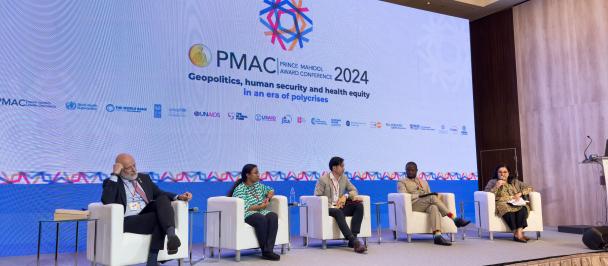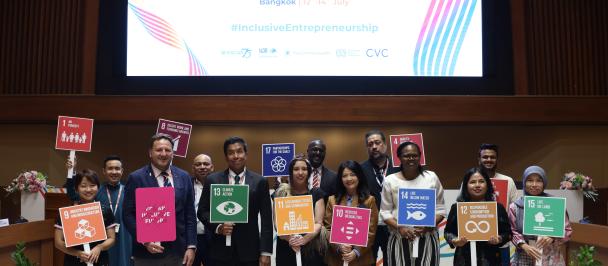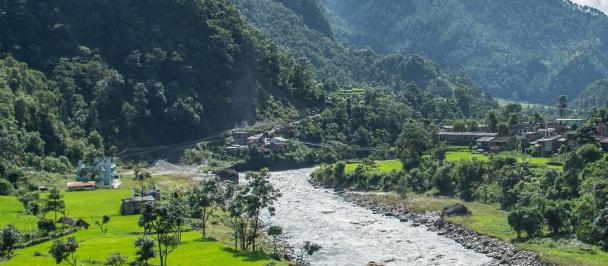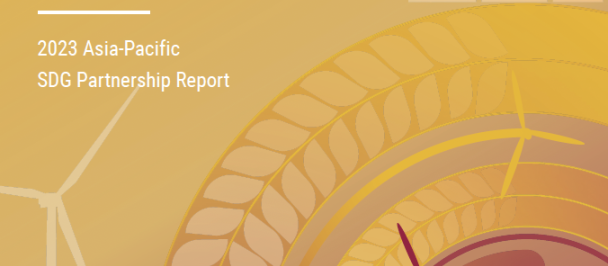8 Policy Recommendations to Ensure Recovery Packages Reach those Left Behind
Designing COVID-19 Policy Responses for those Small Enough to Fail
May 7, 2020
How do we ensure recovery packages are structured to protect the most vulnerable first, ensuring we leave no one behind.
The COVID-19 ‘Great Lockdown’ has plunged the global economy into a recession and created a jobs and livelihoods crisis of historic magnitude. In Asia-Pacific, the crisis is projected to wipe out ten percent of working hours – equivalent to 175 million full-time workers – in the second quarter of 2020 alone, with informal sector workers most impacted. Asia-Pacific is expected to have its lowest growth since the 1960s, and the economic fallout could push 370 million additional people in the region into poverty.
In our last post we joined the many voices calling to prioritise support to those hit hardest – particularly micro, small and medium-sized enterprises (MSMEs) and informal sector workers – and to use the crisis as a critical juncture to push transition to fairer and greener economies.
To date, countries have committed $8 trillion in fiscal stimulus (2,400+ actions and counting). But how do we ensure recovery packages are structured to protect the most vulnerable first and to push transition to more equal and resilient societies? How can we learn from the mistakes of the 2008 financial crisis, when bailouts of carbon-intensive industries led to the biggest leap in emissions in 50 years?
It may be comforting to imagine that we can focus first on short-term measures before turning our minds to the future. However, as Heather Marquette said in a recent blog for Oxfam, “We know… that ‘sequencing’ is a myth and that we can’t think about social and political issues in terms of ‘triaging’ – dealing with the most visible issues first.” Emergency responses will have long-term, systemic impacts that fundamentally reshape our societies.
As Youth Co:Lab, we are focused on how to mitigate the disproportionate socio-economic impacts of the crisis on young people in ways that also reduce their vulnerabilities in the long-run. Young people are more likely to work in precarious jobs in the informal sector; and less likely to have assets, savings or social protection. In Asia-Pacific, 86 percent of youth work in the informal sector, compared with 67 percent of adults. The first month of the crisis led to a 22 percent drop in incomes of informal workers in the region.
To support the design of policy responses targeted to MSMEs and informal sector workers – among whom youth are overrepresented – we have produced a compilation of policy trackers, research, articles, and other resources offering guidance and insights. Please take a look and let us know what we are missing.
In this post, we highlight key considerations for designing COVID-19 policy responses to support those ‘small enough to fail’ and to rebuild our economies in ways that reduce their vulnerability in the long run:
1. The informal economy is hard to reach, so we need to try harder: Most COVID-19 relief efforts to date in Asia-Pacific have been administered through pre-existing formal relationships between governments, businesses and workers. Income and business tax cuts and deferrals don’t reach the informal sector; nor do payroll wage support or unemployment insurance schemes. Soft loans to SMEs sound good; but in practice the businesses they reach in many Asia-Pacific countries are comparatively large, while informal micro-enterprises are left out. Governments such as Malaysia have extended soft loans to micro-enterprises, but on the condition that they register with revenue authorities. After expanding their potential tax base in this way, governments must ensure that the burden of post-crisis revenue raising does not fall on the poorest. In addition to cash transfers (below), governments can use revenue relief measures that do reach the informal sector, such as utility fee cuts.
2. Act fast to avoid permanent poverty traps: If vulnerable workers and their households can’t access cash quickly during the crisis, they are compelled to sell productive assets to survive. Think of a street vendor forced to put their business on hold during lockdown, who then has to sell their cart to cover basic needs. This hampers their chances of economic recovery when the crisis eases. To avoid such poverty traps, governments can i) mobilise existing social assistance schemes by broadening eligibility, increasing benefits and removing conditionality; and ii) develop localised strategies to target those not reached by existing schemes, including the ‘new poor’.
3. Draw on what you have and build back better systems: When it comes to expanding relief (fast), governments in Asia-Pacific should draw on all mechanisms at their disposal. Where cash or in-kind (e.g. food) schemes already exist targeting households (such as Indonesia’s PKH cash transfer) or occupations (such as India’s PM-Kisan farmer scheme), governments can leverage them simultaneously. Digital payments are preferable – as long as they do not exclude the poorest. Securing food supply chains is critical for avoiding deprivation. Countries that have the building blocks of financial accounts, digital ID, and mobile technology (South Asia’s ‘JAM’ trinity) can leverage their strengths and build better delivery systems. The crisis has demonstrated the weaknesses of existing social protection systems, and 159 countries have now introduced 752 new social protection measures. We have an opportunity to strengthen social safety nets as investments in resilience.
4. Be expansive: Governments are (justifiably) keen to target limited resources to those in greatest need. The bad news is that poverty-targeted programmes (including flagship schemes in Asia-Pacific) have a poor track record when it comes to targeting: they exclude high numbers of intended recipients. In the context of COVID-19, lengthy means-testing processes will condemn vulnerable groups to poverty traps (see above); and still exclude many in need, particularly the ‘new poor’. There is also a risk that targeting undermines social cohesion if it is seen as unfair. Governments of course need to consider trade-offs around cost, coverage, level, progressivity, speed, and political economy. But they should not fear creating unintended ‘winners’ (in fact the reverse). In Bangladesh, district administrators are using innovative means to try and target those in need. Japan has expanded cash transfers to all who apply – not only those who can prove loss in income – to speed up delivery. A recovery universal basic income does away with targeting considerations (although introduces others). Universal schemes are much more effective in reaching the poor.
5. Remember the robot reserve army (and other trends): COVID-19 is accelerating long-term trends related to digitisation, telework, e-commerce, the gig economy, automation and robotization. The crisis is shaping the future of work by further empowering the ‘robot reserve army’ who can take over from workers who do routine, automatable, customer-facing jobs such as checkout operators. The virus has accelerated this trend in China. COVID-19 policy responses must take account of the interaction of the crisis with long-term trends and support those whose jobs are most at risk – through upskilling, strengthening worker protections and bargaining power, and closing the digital divide.
6. No blank cheques to big business: There have been vital calls from across the global community to place conditions on COVID-19 stimulus packages to push transition to greener, fairer, and more resilient societies. The UN Secretary General has called on governments not to bail out carbon-intensive industries; and instead to direct stimulus towards green jobs, where MSMEs play a critical role. And there is a business case: new Oxford research finds that green stimulus projects have a higher return on government investment than alternatives. Several countries have barred companies registered in tax havens from bailouts (see TJN's “bail or bailout” test). South Korea has committed to a Green New Deal for COVID-19 recovery. To enhance resilience, governments can condition bailouts to corporations on protections for MSMEs and workers – such as commitments to honour their supplier contracts and accelerate payment terms or to procure more from local firms.
7. Help businesses by helping people (and vice versa): “A modern economy is a complex web of interconnected parties… Everyone is someone else’s employee, customer, lender”. Policies that smooth income shocks help to maintain consumer spending and keep businesses afloat. And policies that keep businesses afloat reduce job losses and income shocks. And so on. Supporting both small businesses and households to survive involves liquidity measures (e.g. deferral of financial obligations, credit) and solvency measures (e.g. transfers, subsidies). Particularly in contexts of high informality, Asia-Pacific governments must look holistically at their support to households and businesses – not only to protect the ‘web’ for recovery, but to rebuild and strengthen it for the long-term.
8. Policymaking must be adaptive: A defining feature of the pandemic is uncertainty about the scale and nature of its socio-economic impacts. It is impossible to model the interacting and cascading knock-on effects of millions of responses and decisions by governments, businesses, and individuals. In the face of such uncertainty, policymaking must be adaptive. However, adaptiveness doesn’t mean foregoing a long-term vision. Particularly when it comes to MSMEs and the informal sector, policymakers must use their deep contextual knowledge of the underlying contours of the economy to make choices that build resilience, inclusion and sustainability.
Common to all these considerations is the message that COVID-19 policy responses must be ‘best-fit’, rather than ‘best-practice’; taking into account political settlement, state capabilities, position within the global economy, and much more. It goes without saying that some Asia-Pacific countries are much more constrained than others in reconfiguring their economic playing field.
Yet all governments are making choices (implicit or explicit) in the design of their recovery packages that will be hugely consequential over the long-term. It may be appealing to try and design to ‘return to normal’. But we know normal wasn’t good enough, particularly for those ‘small enough to fail’. Instead, let’s ensure that our choices disrupt existing structures of exclusion and inequality and build towards something better.
Co-led by UNDP and Citi Foundation, Youth Co:Lab establishes a common agenda for countries in Asia-Pacific to empower and invest in youth so that they can accelerate the implementation of the Sustainable Development Goals (SDGs) through leadership, social innovation and entrepreneurship. Read more about Youth Co:Lab here.
UNDP is providing the technical lead in the UN’s socio-economic recovery efforts to COVID-19. UNDP is on the ground supporting 170 countries and territories to prepare for, respond to and recover from the pandemic, focusing particularly on the most vulnerable. Read more on UNDP’s integrated response to COVID-19 here.

 Locations
Locations



